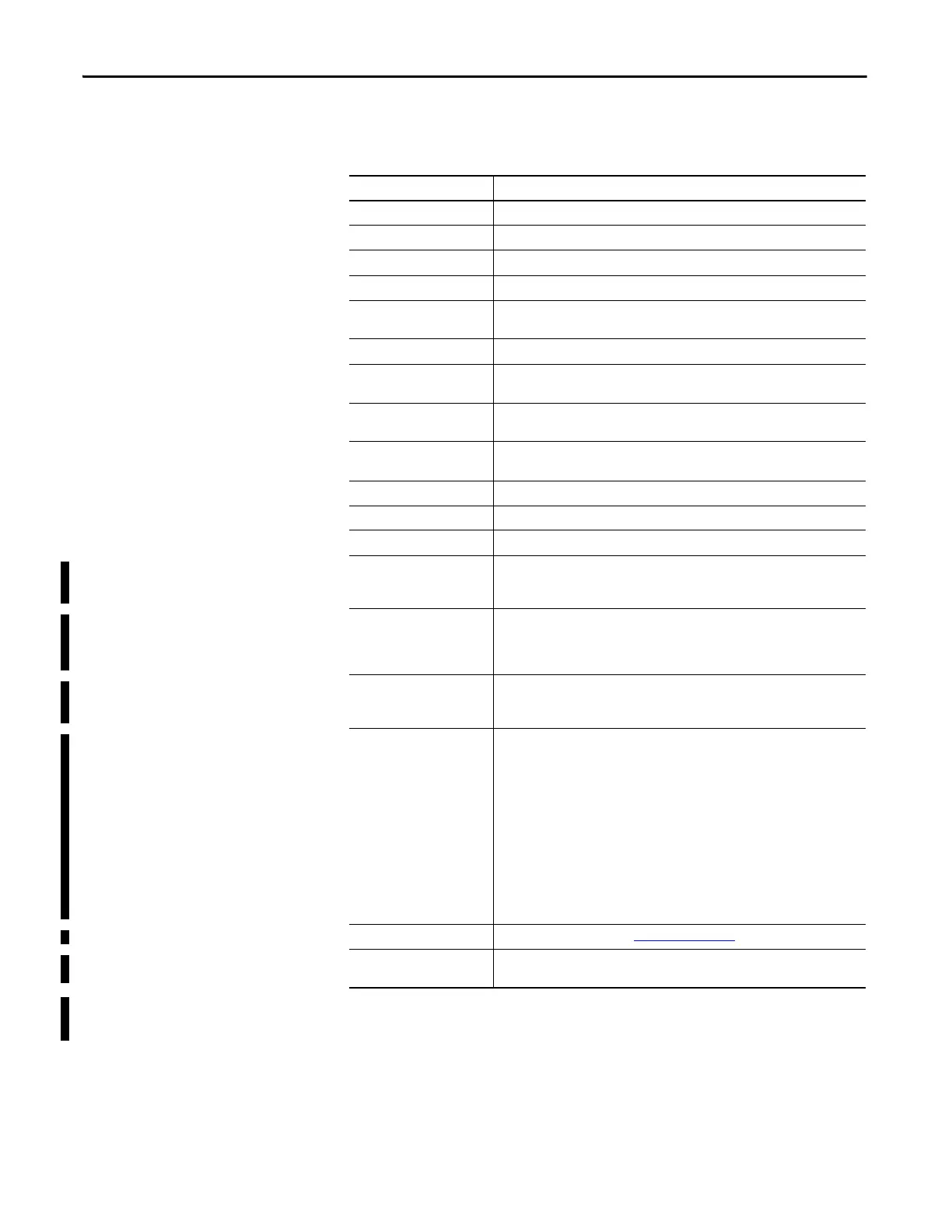112 Rockwell Automation Publication 1756-UM535D-EN-P - November 2012
Chapter 6 Configure the Redundancy Modules
These parameters are indicated in the Module Info tab.
In addition, you can click Change to edit the User-Defined Identity parameters
to meet your application needs.
Table 17 - Module Info Tab - Parameters Indicated
Parameter Description
Vendor Name of the redundancy module’s vendor.
Product Type General product type of the redundancy module.
Product Code CIP product code for the redundancy module.
Revision Major and minor revision information for the redundancy module.
Redundancy Module Serial
Number
Serial number of the redundancy module.
Product Name Predefined catalog name of the redundancy module.
General Status General state of the redundancy module. Possible values include Startup, Load, Fault,
and OK.
Major Fault Redundancy module’s major fault status. When a major fault is detected, the system
does not provide redundancy support.
Minor Fault Redundancy module’s minor fault status. When a minor fault is detected the system
continues to provide redundancy support.
Error Code Error code related to the fault if one exists.
Error Message Text-based message describing the error if a fault exists.
Recovery Message Text-based message that indicates the recovery from a fault.
Total Indicates the number of channel switchovers that have occurred from CH1 to CH2 and
vice versa on the module since its last powerup. It is reset to 0 automatically by
firmware on a power cycle.
Periodic Indicates the number of switchovers that have occurred between CH1 and CH2 over
the last 10-second interval. The counter is constantly updated to reflect the value
recorded at every 10-second interval. The counter is automatically reset to 0 on a
power cycle.
Max Periodic Switchovers The maximum number recorded in the Periodic counter. The time of the update is
recorded every time the counter is updated. The counter is automatically reset to 0 on
a power cycle and may also be reset by clicking the Reset button.
(1)
(1) The Periodic counters can be used to identify a burst of switchovers that may take place due to intermittent channel failures within
a few seconds. The recorded time may be helpful to correlate the switchover occurrences with any external failures that may have
occurred on the fiber cables.
CH1 Status Fiber Channel 1 status.
The status shows the operating condition of the respective fiber channels in terms of
one of the following values:
– Unknown - Operating state is not yet determined
– Active - Channel is operating normally as the ACTIVE channel
– Redundant - Channel is operating normally as the REDUNDANT channel
– Link Down - Channel is disconnected. Causes can be: the cable is
disconnected/broken/damaged; signal is attenuated, connector is loose, the
partner 1756-RM2 module is power down or in a major fault state
– No SFP - No transceiver was detected, it has failed, it is loosely connected, it is
not installed
– SFP !Cpt - Transceiver is not a Rockwell Automation supported unit
– SFP Fail - Transceiver is in a failed state
CH2 Status Fiber Channel 2 status. Refer to CH1 Status on page 112
.
Chassis Platform Configuration Indicates whether configuration is enhanced or standard (version 19.05x and above
always displays ‘enhanced’).

